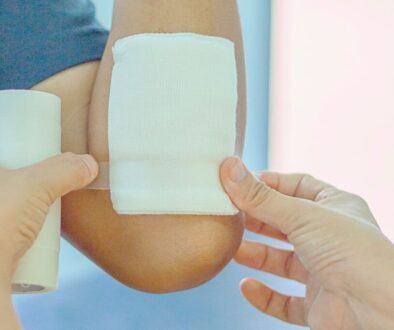Effective Home Care For Ulcer Wounds

Who Is At Risk?
Individuals at high risk for bedsores include those with limited mobility. This group consists of bedridden patients and wheelchair users. Older adults, especially in nursing homes, are highly susceptible.
Additionally, certain factors can elevate the risk of pressure injuries for individuals who:
- Are diagnosed with chronic conditions like diabetes
- Experience inadequate nutrition
- Smoke
- Have delicate or fragile skin
When pressure injuries are identified and addressed promptly, they heal within a few weeks. However, if left untreated, they can deteriorate rapidly.
Symptoms Of Pressure Injuries
Pressure injuries, also known as bedsores or ulcers, usually start as red, blue, or purplish patches on the skin that don’t turn white when pressed. Unfortunately, these patches can quickly become blisters and open sores, leading to infections affecting deeper tissues, such as muscle, joints, or bone.
The affected skin may feel warm, smell foul, and appear swollen. Symptoms may include fever and chills if the infection proliferates to the bloodstream. Confusion can also occur. If left untreated, it can likely progress to septic shock.
In severe cases, pressure injuries can become life-threatening. It’s crucial to consult a healthcare provider at the first signs of a pressure injury. These injuries usually appear as soft patches of skin that stay red for 30 minutes or longer, even after the pressure is relieved.
Stages Of Bedsores Or Ulcer Wounds
Recognizing the stages of bedsores is crucial for prevention and treatment. This knowledge helps caregivers and healthcare professionals spot early signs. Taking action can promote healing and improve patient comfort.
- Stage 1. The skin may display red, blue, or purplish discoloration and feel warm or itchy. Notably, the affected area does not blanch when pressed.
- Stage 2. The skin ruptures, forming a sore that looks like an abrasion or blister. This is often accompanied by discoloration around the wound.
- Stage 3. The sore advances and develops a crater-like appearance. The surrounding skin may show dark patches.
- Stage 4. Injury can affect muscles, bones, or joints, increasing the risk of serious infections, such as osteomyelitis or sepsis.
- Unstageable Full-Thickness Pressure Injury. A stage 3 or 4 injury may be hidden by black dead tissue known as eschar. It can also be covered by thick, creamy yellow, gray/black, or white slimy tissue called slough. This covering complicates the assessment of the injury’s severity.
- Deep Tissue Pressure Injury. A distinct dark red, maroon or purple patch may appear on the skin. This patch does not blanch when pressed. Alternatively, a severe wound or blister filled with blood can be observed through a break in the skin.
Recognizing these stages is vital in providing adequate care and improving patient outcomes.

How Are Ulcer Wounds Treated?
Ulcer wounds need careful management to promote healing and prevent complications. Fortunately, key home care strategies can help. While non-surgical treatments exist, severe cases may require surgery.
Home Care
Prompt treatment of bedsores is crucial, even in the early stages, as they can worsen quickly without proper care. Here are some effective home ulcer care strategies:
- Elevate the affected leg or area using a pillow or foam cushion. This will help reduce pressure on the injured site, facilitating healing.
- Dust plain talc on areas susceptible to friction to minimize irritation.
- Specialized dressings can protect the wound and encourage healing. Options include moist dressings, hydrogels, hydrocolloids, collagen wound dressings, and antimicrobial dressings.
- For open sores, carefully follow your healthcare provider’s cleaning instructions. This will help minimize the likelihood of infection. Typically, this involves using saline or saltwater to remove dead tissue.
- If the ulcer becomes infected, antibiotic treatment is required. Your doctor may prescribe oral antibiotics if the infection reaches deeper tissues or bones. It’s also important to note that antibiotics may be given even without an infection to reduce infection risks.
- Pain relief medications may be provided to manage discomfort during dressing changes. As the ulcer heals, pain should gradually diminish.
- Proper nutrition is vital for healing. Ensure you get enough calories, protein, and essential nutrients.
Non-Surgical Management
See a healthcare professional for stages 3 or 4 bedsores is advisable. Depending on the ulcer’s severity, healing can take weeks to months.
When managing an ulcer, a healthcare provider may:
- Irrigate or clean the wound using soap and water or saline solution.
- Apply specialized medical dressings to facilitate healing. One of the latest innovations to consider are amniotic allografts.
Debridement may be needed for deep, severe pressure ulcers. This procedure removes dead tissue with a scalpel. A local anesthetic is given to numb the area since the surrounding tissue remains sensitive.
Surgical Management
Surgical intervention is necessary for stage 3 or 4 pressure ulcers that are deep or cover a large area. A skin graft may be needed to close the wound and promote healing.
Preventive Measures
Several effective strategies can help prevent pressure ulcers. Here are some essential tips to consider:
- For those on bed rest, changing positions every 2 hours is essential to prevent pressure sores. Regular repositioning helps distribute body weight. Using smooth bedding and avoiding leg overlap reduces pressure points. A soft pillow between the legs aids in alignment, and elevating the heels with a foam pad protects them from sores.
- Wheelchair users should change positions every 10 to 15 minutes to avoid pressure sores. If they can’t reposition themselves, assistance should be sought at least once an hour. Training caregivers to help with these adjustments can enhance comfort and reduce risks.
- Investing in an alternating air mattress benefits immobile individuals and their caregivers. These mattresses improve blood circulation and relieve skin pressure, significantly lowering the risk of pressure ulcers.
- When lifting an immobile person, it’s essential to use sheets, a harness, or a lifting device instead of pulling on their arms or legs. This method offers better control and reduces the risk of injury for both the caregiver and the individual.
In addition to these specific strategies, other good habits to observe include:
- Proper skin care. Regular skin care is crucial for preventing pressure ulcers. Clean any soiled areas right away with warm water and mild soap. Moisturizing dry skin helps prevent cracking and irritation. Keeping the skin warm and dry is also essential, as excess moisture can raise the risk of skin infections.
- Nutrition and hydration. A well-balanced diet with vitamins and nutrients is crucial for skin health. Proper hydration is also essential. Staying hydrated helps maintain blood flow, which is vital for preventing sores.
- Regular exercise. Regular physical activity is beneficial whenever possible. For those who are immobile, gentle limb exercises can improve circulation. They also help maintain muscle tone. This supports overall health and prepares the body for mobility.
- Avoiding smoking. Quitting smoking is crucial for anyone at risk of pressure ulcers. Non-smokers should also avoid secondhand smoke. Smoking impairs circulation and slows wound healing, making it essential for optimal health.
Observing preventive measures can reduce the risk of pressure ulcers and improve skin health. As a result, the quality of life for at-risk individuals is enhanced, and they can maintain their comfort and dignity.

Protecting Against Ulcer Wounds At Home
Bedsores are a preventable health concern that demands prompt intervention and proactive home ulcer care measures. By understanding the risk factors, stages, and treatment options, individuals and caregivers can effectively manage and prevent these injuries, ultimately enhancing the quality of life for those at risk. Take action today to educate yourself and others on effective prevention strategies!
Heal Ulcers, Burns, & Surgery Wounds With Break-Through Amniotic Allograft Treatments
Experience the future of wound care with our advanced amniotic allograft treatments. Say goodbye to slow healing. Our innovative solutions promote faster recovery from pressure wounds, ulcers, burns, and surgical wounds. Trust the power of science for your healing journey. Regain your comfort and health today! See if you are eligible for treatment here.

About The Author
Corinne Grace is a full-time writer living in the Philippines. She has a nursing degree from Riverside College. Her background in nursing informs her perspective, allowing her to weave in themes of health, empathy, and resilience into her work.




